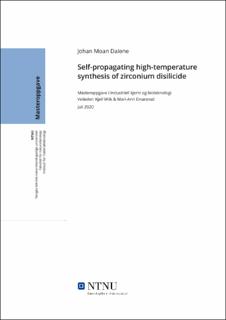| dc.contributor.advisor | Wiik, Kjell | |
| dc.contributor.advisor | Einarsrud, Mari-Ann | |
| dc.contributor.author | Dalene, Johan Moan | |
| dc.date.accessioned | 2021-09-28T18:13:03Z | |
| dc.date.available | 2021-09-28T18:13:03Z | |
| dc.date.issued | 2020 | |
| dc.identifier | no.ntnu:inspera:59532294:30357297 | |
| dc.identifier.uri | https://hdl.handle.net/11250/2785291 | |
| dc.description.abstract | I denne oppgaven ble en selv-utviklet reaktor som benyttet en Mg-BaO2 antennelsesblanding i en rørovn bruk til SHS av ZrSi2. Litteratur om forbrenningssyntese, zirkonium, silisium og Zr-Si systemet ble studert for å etablere en forventning til hvordan Zr-Si pulverblandinger oppfører seg under forberedelse av blandingen og SHS. Innflytelsen til mølleparametere under ko-mølling av zirkonium og silisium ble undersøkt ved karakterisering av møllede bladninger ved XRD og SEM. Innflytelsen til reaktor-, prøve-, og eksperimentegenskaper ble undersøkt med forskjellige konfigurasjoner av SHS etterfulgt av karakterisering av prøver ved XRD og SEM. Silisotermisk reduksjon av ZrO2 ble undersøkt som en mulig negativ innflytelse på SHS ved termisk analyse og XRD. Reaktiviteten mellom zirkoniumsilisider or zirkonium og silisium ble undersøkt for å bestemme dens effekt på SHS av zirkoniumsilisider. Resultatene av SHS-eksperimentene avslørte at forbrennigsdannelsen av ZrSi2 var sensitiv og ble negativt påvirket av eksplosiviteten til igniteren, spredning av varme fra prøvene, utilstrekkelig størrelsesreduksjon av zirkoniumpartiklene, og fast-stoff diffusjon før antennelse. Silisotermisk reduksjon og reaktivitet mellom zirkoniumsilisid og zirkonium og silisium ble betraktet til å ha neglisjerbr effekt på SHS av zirkoniumsilisider. Basert på tilgengelig litteratur om den suksessfulle stor-skala syntesen av MoSi2, ble det fastslått at størrelsesreduksjon av zirkonium er den største utfordringen i stor-skala applikasjon av SHS av ZrSi2. | |
| dc.description.abstract | In this thesis, a self-developed reactor utilizing a Mg-BaO2 igniter mixture in a tube furnace was used for SHS of ZrSi2. Literature on combustion synthesis, zirconium, silicon, and the Zr-Si system, was reviewed to establish an expectation of how Zr-Si powder mixtures behave during mixture preparation and SHS. The influence of milling parameters during co-milling of zirconium and silicon was investigated by characterization of milled mixtures by XRD and SEM. The influence of reactor, sample, and experiment properties on the combustion reaction was investigated with different configurations of SHS followed by characterization of reacted samples by XRD and SEM. Silicothermic reduction of ZrO2 was investigated as a possible negative influence on SHS by thermal analysis and XRD. The reactivity between zirconium silicides and zirconium and silicon was investigated to determine its effect on SHS of zirconium silicides. Results of the co-milling of zirconium and silicon revealed that large milling media causes flattening and deforming of zirconium particles, while small milling media causes crushing of zirconium particles. The results of the SHS-experiments revealed that the combustion formation of ZrSi2 was sensitive and negatively affected by the explosivity of the igniter, dissipation of heat from the samples, insufficient size reduction of the zirconium particles, and solid-state diffusion before ignition. Silicothermic reduction and reactivity between zirconium silicide and zirconium and silicon was considered to have a negligible effect on SHS of zirconium silicides. Based on available literature on the successful large-scale SHS of MoSi2, the main challenge of large-scale application of SHS of ZrSi2 was determined to be sufficient size reduction of the zirconium powder. | |
| dc.language | | |
| dc.publisher | NTNU | |
| dc.title | Self-propagating high-temperature synthesis of zirconium disilicide | |
| dc.type | Master thesis | |
